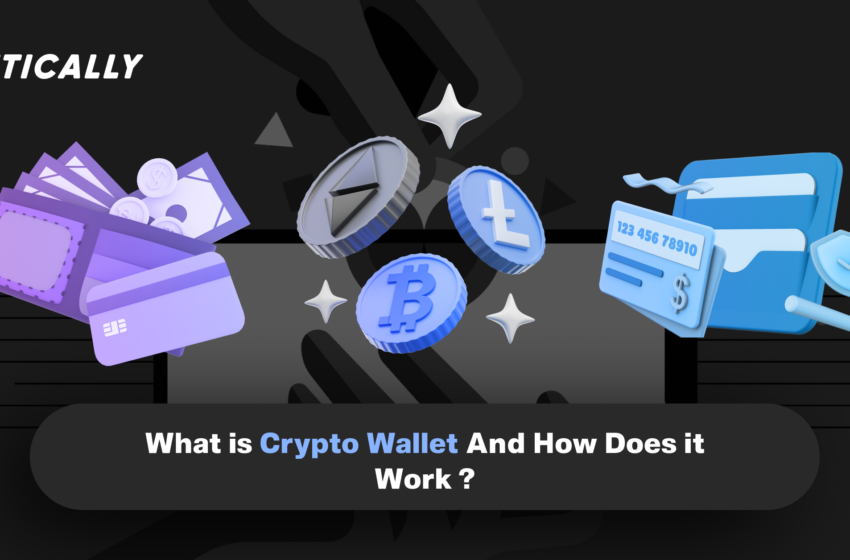Regulation to Define 2026: DYdX’s Charles d’Haussy Predicts Domestic DATs
What is Crypto Wallet And How Does it Work?
(Originally posted on : NFTICALLY )
Interested in blockchain and cryptocurrency basics? If this is the case, one of the first things you should know about is What is a crypto wallet and how does it work?
Here, you’ll find all the information you need to know about a crypto wallet in one place. After reading it from beginning to end, you’ll have all the necessary knowledge!
So, what exactly are you putting off doing now? To begin, let’s look at the most fundamental functions of a wallet!
Crypto Wallet Explained
Let’s take a moment to consider where you keep your hard-earned money before we continue. You don’t carry it with you all the time, do you? If you’re anything like me, you keep your cash in a piggy bank or leather wallet.
However, it is best to keep your money in a secure location. The same fundamental principles apply to a cryptocurrency wallet as to a traditional wallet.
As a result, you’ll be able to transfer and receive Bitcoins and other cryptocurrencies (there are already over 19,000 of them!) by getting a crypto wallet.
I’ll go into further detail about how a cryptocurrency wallet works now that you know what it’s for.
How Does a Crypto Wallet Work?
I initially used a real-world leather wallet as an example since a wallet is an actual container where you put your cash. However, things are slightly different in the digital realm of cryptocurrencies and blockchain technology.
Because cryptocurrencies do not have a physical form, they cannot be kept in a wallet. Instead, the blockchain comprises transaction records showing whose private and public keys own the cash.
I’ll briefly go through the functions of a wallet address, a private key, and a public key to ensure you’re on the same page since they’re all connected.
Like a bank account number, a wallet address is a convenient way to keep track of your money. When it comes time to transfer money, you’ll need the bank account number of the person you’ve shared it with. This might be for various reasons, such as being paid by your company, a client, or getting birthday money from loved ones!
You must provide your wallet address if someone wants to transfer your bitcoin. This implies that no one else can access your money since no two wallet addresses are identical. The amount of wallet addresses you may generate is also unlimited.
Here’s the wallet address of Bitcoin creator Satoshi Nakamoto (thought to belong).
1A1zP1eP5QGefi2DMPTfTL5SLmv7DivfNa
As you can see, it uses both upper- and lower-case characters and digits. As most blockchains are transparent, finding out how much money a given cryptocurrency wallet contains and the transactions the owner has previously done is simple.
The blockchain is regarded as “pseudonymous” since a bitcoin wallet address does not expose the real-world identity of its owner.
How do a wallet’s private and public keys relate?
The wallet address is much like a bank account number, so now I’ll describe how you get your hands on the money. Often, people confuse a public key with a public wallet address; however, this is not the case.
Understanding that no two addresses may be the same regarding bitcoin wallets is essential. The private key lets you access the money linked to the crypto wallet address you entered in the address field.
You must enter your secret password for money transfers between your bank accounts. This is a real-world example. Nobody, not even the bank, has access to this password. Otherwise, someone may transfer funds from your bank account if they knew what it was!
The function of a public key is identical to that of a private key, which is unique to a particular crypto wallet address. A public key is also an option. Your wallet address and a public key are mathematically connected! However, it is a “reworked” version, which I will describe in further detail below.
A hash function converts a group of characters or numbers (referred to as “input”) into another set of characters or digits (referred to as “output”) (called an “output”). An additional degree of protection is provided by this, ensuring that your wallet is safe from hackers. To make things easier to understand, I’ll give you an example.
Private Key: 03bf350d2821375158a608b51e3e898e507fe47f2d2e8c774de4a9a7edecf74eda
Public Key: 99b1ebcfc11a13df5161aba8160460fe1601d541
Now, I know what you’re thinking: aren’t these two sets of keys the same? Yes, the two keys seem unrelated to the naked eye, but software recognises their connection. This demonstrates your ownership of the coins and allows you to move money around at will!
It’s essential to keep in mind that the information presented here is very technical. On the other hand, using a bitcoin wallet takes care of everything for you. It’s like sending an email via the internet!
Gmail and Hotmail, for example, handle all of your email transactions for you, and a cryptocurrency wallet does the same for your bitcoin transactions.
Wrapping Up
Hope this blog article about cryptocurrency wallets was helpful to you. All of the information presented here should help you make an informed decision about whether or not to use a wallet.
Also, I’m curious as to which wallet you prefer. Do you have any other ideas that I didn’t include? Please let me know if this is the case in the comments area.
It’s a great way to keep up to date on the newest NFT news and events. Our newsletter may be found at www.nftically.com if you want to sign up for our mailing list.








 Bitcoin
Bitcoin  Ethereum
Ethereum  Tether
Tether  XRP
XRP  USDC
USDC  TRON
TRON  Lido Staked Ether
Lido Staked Ether  Dogecoin
Dogecoin  Figure Heloc
Figure Heloc  Cardano
Cardano  WhiteBIT Coin
WhiteBIT Coin  Wrapped stETH
Wrapped stETH  Bitcoin Cash
Bitcoin Cash  Wrapped Bitcoin
Wrapped Bitcoin  USDS
USDS  Binance Bridged USDT (BNB Smart Chain)
Binance Bridged USDT (BNB Smart Chain)  Chainlink
Chainlink  Wrapped eETH
Wrapped eETH  Monero
Monero  WETH
WETH  Stellar
Stellar  Hyperliquid
Hyperliquid  Zcash
Zcash  Ethena USDe
Ethena USDe  Coinbase Wrapped BTC
Coinbase Wrapped BTC  LEO Token
LEO Token  Litecoin
Litecoin  Sui
Sui  Avalanche
Avalanche  sUSDS
sUSDS  Hedera
Hedera  Shiba Inu
Shiba Inu  Dai
Dai  USDT0
USDT0  PayPal USD
PayPal USD  Mantle
Mantle  Toncoin
Toncoin  Cronos
Cronos  Ethena Staked USDe
Ethena Staked USDe  World Liberty Financial
World Liberty Financial  Uniswap
Uniswap  Polkadot
Polkadot  MemeCore
MemeCore  USD1
USD1  Canton
Canton  Aave
Aave  Rain
Rain  Bitget Token
Bitget Token  Tether Gold
Tether Gold  Falcon USD
Falcon USD  OKB
OKB  Bittensor
Bittensor  NEAR Protocol
NEAR Protocol  Ethereum Classic
Ethereum Classic  Jito Staked SOL
Jito Staked SOL  BlackRock USD Institutional Digital Liquidity Fund
BlackRock USD Institutional Digital Liquidity Fund  Binance-Peg WETH
Binance-Peg WETH  Pi Network
Pi Network  syrupUSDC
syrupUSDC  Aster
Aster  Pepe
Pepe  Internet Computer
Internet Computer  Solana
Solana  Jupiter Perpetuals Liquidity Provider Token
Jupiter Perpetuals Liquidity Provider Token  Ethena
Ethena  HTX DAO
HTX DAO  PAX Gold
PAX Gold  Global Dollar
Global Dollar  Circle USYC
Circle USYC  KuCoin
KuCoin  Ripple USD
Ripple USD  Sky
Sky  syrupUSDT
syrupUSDT  BFUSD
BFUSD  Binance Bridged USDC (BNB Smart Chain)
Binance Bridged USDC (BNB Smart Chain)  Worldcoin
Worldcoin  Ondo
Ondo  Pump.fun
Pump.fun  Gate
Gate  Rocket Pool ETH
Rocket Pool ETH  Binance Staked SOL
Binance Staked SOL  Wrapped BNB
Wrapped BNB  POL (ex-MATIC)
POL (ex-MATIC)  Aptos
Aptos  Midnight
Midnight  Arbitrum
Arbitrum  Official Trump
Official Trump  Function FBTC
Function FBTC  Algorand
Algorand  Solv Protocol BTC
Solv Protocol BTC  Lombard Staked BTC
Lombard Staked BTC  Liquid Staked ETH
Liquid Staked ETH  NEXO
NEXO  Cosmos Hub
Cosmos Hub